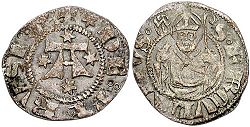
Herculanus of Perugia
Encyclopedia
Saint Herculanus of Perugia (died 549) was a bishop of Perugia and is patron saint
of that city
. His main feast day is November 7; his second feast is celebrated on March 1. According to Saint Gregory the Great in his Dialogues, Herculanus suffered martyrdom when Totila
, king of the Ostrogoths, captured Perugia in 549.
Before the city was captured, Herculanus is said to have tried to save the city with an old ruse: he fed the last sack of grain
to the last lamb
. This was meant to give the Ostrogoth forces the impression that the Perugians had food to spare, and were able to feed a weak lamb with their precious grain. With food to spare, they were thus able to withstand the siege. However, Totila was not fooled by this trick and captured the city just the same.
This same trick has also been attributed to Gagliaudo, who saved his city (Alessandria
)--successfully—from the forces of Frederick Barbarossa. An interpretation of the tale is found in Umberto Eco's
novel Baudolino
.
Totila is said to have commanded Herculanus to be completely flayed
. However, the Ostrogoth soldier asked to perform this gruesome task took pity on the bishop and decapitated
Herculanus before the flaying had been completed.
Gregory writes that forty days after Herculanus' head had been cut off, it was found to have been reunited to the body.
The inhabitants of the castle of Cisterna, above the Puglia river, were under Perugian rule; they had to send three pounds of wax
to Perugia for the feast of St. Herculanus.

Patron saint
A patron saint is a saint who is regarded as the intercessor and advocate in heaven of a nation, place, craft, activity, class, clan, family, or person...
of that city
Perugia
Perugia is the capital city of the region of Umbria in central Italy, near the River Tiber, and the capital of the province of Perugia. The city is located about north of Rome. It covers a high hilltop and part of the valleys around the area....
. His main feast day is November 7; his second feast is celebrated on March 1. According to Saint Gregory the Great in his Dialogues, Herculanus suffered martyrdom when Totila
Totila
Totila, original name Baduila was King of the Ostrogoths from 541 to 552 AD. A skilled military and political leader, Totila reversed the tide of Gothic War, recovering by 543 almost all the territories in Italy that the Eastern Roman Empire had captured from his Kingdom in 540.A relative of...
, king of the Ostrogoths, captured Perugia in 549.
Before the city was captured, Herculanus is said to have tried to save the city with an old ruse: he fed the last sack of grain
GRAIN
GRAIN is a small international non-profit organisation that works to support small farmers and social movements in their struggles for community-controlled and biodiversity-based food systems. Our support takes the form of independent research and analysis, networking at local, regional and...
to the last lamb
Domestic sheep
Sheep are quadrupedal, ruminant mammals typically kept as livestock. Like all ruminants, sheep are members of the order Artiodactyla, the even-toed ungulates. Although the name "sheep" applies to many species in the genus Ovis, in everyday usage it almost always refers to Ovis aries...
. This was meant to give the Ostrogoth forces the impression that the Perugians had food to spare, and were able to feed a weak lamb with their precious grain. With food to spare, they were thus able to withstand the siege. However, Totila was not fooled by this trick and captured the city just the same.
This same trick has also been attributed to Gagliaudo, who saved his city (Alessandria
Alessandria
-Monuments:* The Citadel * The church of Santa Maria di Castello * The church of Santa Maria del Carmine * Palazzo Ghilini * Università del Piemonte Orientale-Museums:* The Marengo Battle Museum...
)--successfully—from the forces of Frederick Barbarossa. An interpretation of the tale is found in Umberto Eco's
Umberto Eco
Umberto Eco Knight Grand Cross is an Italian semiotician, essayist, philosopher, literary critic, and novelist, best known for his novel The Name of the Rose , an intellectual mystery combining semiotics in fiction, biblical analysis, medieval studies and literary theory...
novel Baudolino
Baudolino
Baudolino is a 2000 novel by Umberto Eco about the adventures of a young man named Baudolino in the known and mythical Christian world of the 12th century.Baudolino was translated into English in 2001 by William Weaver...
.
Totila is said to have commanded Herculanus to be completely flayed
Flaying
Flaying is the removal of skin from the body. Generally, an attempt is made to keep the removed portion of skin intact.-Scope:An animal may be flayed in preparation for human consumption, or for its hide or fur; this is more commonly called skinning....
. However, the Ostrogoth soldier asked to perform this gruesome task took pity on the bishop and decapitated
Decapitation
Decapitation is the separation of the head from the body. Beheading typically refers to the act of intentional decapitation, e.g., as a means of murder or execution; it may be accomplished, for example, with an axe, sword, knife, wire, or by other more sophisticated means such as a guillotine...
Herculanus before the flaying had been completed.
Gregory writes that forty days after Herculanus' head had been cut off, it was found to have been reunited to the body.
The inhabitants of the castle of Cisterna, above the Puglia river, were under Perugian rule; they had to send three pounds of wax
Wax
thumb|right|[[Cetyl palmitate]], a typical wax ester.Wax refers to a class of chemical compounds that are plastic near ambient temperatures. Characteristically, they melt above 45 °C to give a low viscosity liquid. Waxes are insoluble in water but soluble in organic, nonpolar solvents...
to Perugia for the feast of St. Herculanus.


